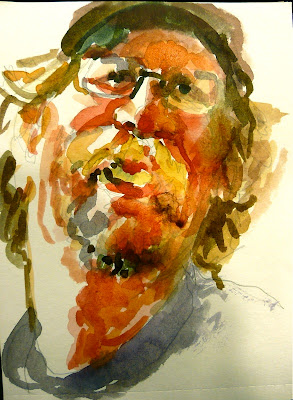
I did this fast little drawing (5 x 7) in my sketch book and decided to paint it. I spent a few more minutes creating little value plans and thumbnails for composition. This guy's face is so entertaining, I think I will do all the variations in composition sooner or later but I need to decide on one for the workshop. I spent the rest of the day installing the new Photoshop Elements 6 for the Mac. It looks exciting with some cool new tools but now I have to learn the darn thing all over again. I hate that they put all the instruction on the internet instead of in a book. I like to have the book open as I go. I guess a trip to the bookstore is in order. I have been working with Elements 2 so it was time to upgrade.
I can't remember whether I have posted the following comments by artist Sue Archer. It was on the CCP Blog awhile back and I saved it for my teaching. It was so perfectly worded and expressed my sentiments on the subject perfectly. If I have posted this before, I think it is worth repeating:
"The drawing process is the heart of art, the foundation of painting. Drawing involves learning how to "see" as an artist. It is during this process that you learn about your "subject", the lines, the shapes, the relationships. This is your "homework", your prep work for painting. It is during this process the artist is designing and composing.
Projecting can be a useful tool to assist the drawing process but it should never used as a crutch. Many accomplished artists project at some time during the drawing process, including the contemporary painter, Joseph Raffael. However they can draw.
They use the camera viewfinder as a cropping and designing tool, documenting a slice of time that will be transformed by the painting process. But this process involves the knowledge of drawing. Raffael's work often is up to 100 inches. Projection of his image helps him with scale and placement of shapes. The painting grows from this image and the artist transforms this into his or her vision.
During this transformation, you should do what artists do when they draw: add & subtract, pick & choose, emphasize & minimize, enhance & reduce. Often there are shapes, colors and values in your image that won't work in your painting. Use what you like and change what doesn't work.
The camera is a great tool for artists but it lies and has its limitations. Different lenses can cause distortions to reality. These need to be addressed. They distort perspective and the artist needs to be able to see this and correct for it. Values can be exaggerated and don't read well if copied verbatim.
So for those of you who feel they come up short on their drawing skills, take a class, carry a sketch book wherever you go, and just draw. You can learn to draw! As Lynn said, drawing is essential to art; it is very satisfying and fun too."
Sue Archer AWS NWS TWSA
Tuesday, May 6, 2008
THE VALUE OF DRAWING
Posted by
Myrna Wacknov
at
9:32 PM
![]()
Labels: art work, color sketch, Words of Wisdom
Subscribe to:
Post Comments (Atom)










































2 comments:
I just ordered "Photoshop 6 The Missing Manual" and may get "PS6 for Dummies" also. I, too, need a reference to walk me through the learning process.
Re drawing: It is fun and gets easier the more you do it. I only get stressed when I'm eager to start painting before I have worked through the drawing. And really, after getting the sketch tweaked sufficiently, you know it so well the paint just flows. Maggie
Myrna, great work lately. I especially enjoyed the work inspired by Rafael. The colors really grabbed me.
I've been all involved in retiring from my day job last Wednesday. I've been partied (3 times) and had family visiting from back East. Needless to say, I haven't done much painting. This afternoon and evening I will get to that. You are so inspirational.
Post a Comment